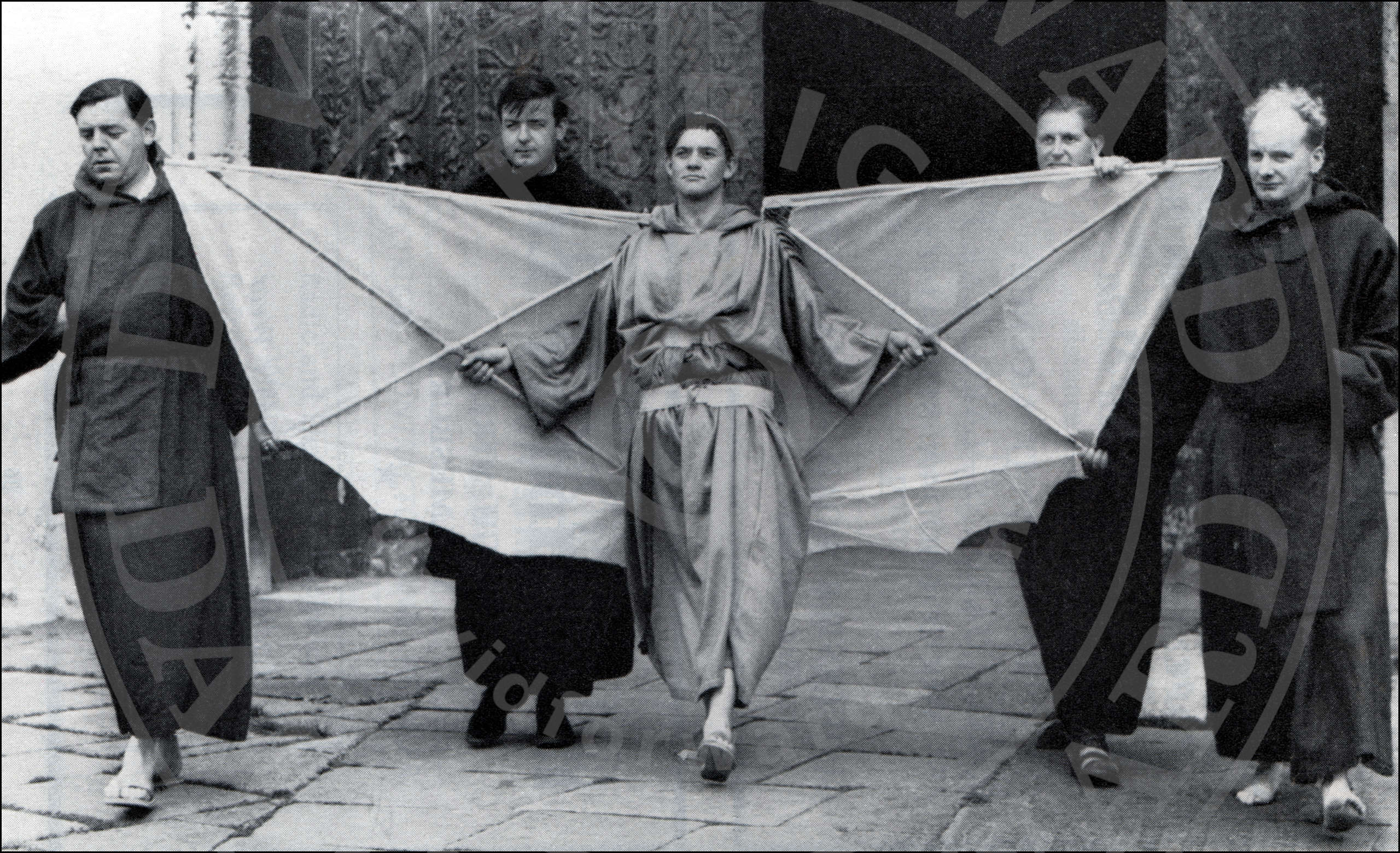
One thousand years ago, a researcher launched himself in the first recorded European flight. His unpowered glider carried him 200 metres – nearly as far as the Wright brothers’ best attempt nine hundred years later. The researcher’s name was Elmer.
Elmer was a monk at Malmesbury Abbey on the edge of the Cotswolds. At that time, Malmesbury was a centre of learning as well known and famous as Oxford University is today. Kings sent their sons to be educated there and each monk had his own area of scholarship.
Some of the monks studied plants or theology. Elmer studied birds. He started with sparrows that hopped and squabbled in the central courtyard. Each day, he studied their flight patterns between the buildings and compared their habits and mannerisms with those of the doves from the abbey dovecote.
A theory began to form in his mind. Men also had two legs and two upper limbs. Perhaps they too could learn to fly. He applied for permission to do further research. When the Abbot, the head of his monastery, granted it, Elmer extended his studies.
He walked down through the hilltop town of Malmesbury and watched the ducks and swans on the river. He startled them into flying away and studied their techniques, noting that the larger swans needed space to speed up before they could take to the air. He even compared birds with local bats, noting that the bat’s wings were formed with skin, rather than feathers.
Then he gathered together all his notes, sketches and ideas and began checking the plausibility of his theory of flight. After much thought, Elmer came to the conclusion that his theory was correct.
Given a large enough pair of wings, men would be capable of flying like birds. He took his theories and conclusions to the Abbot and sought permission to test out his conclusion.
When it was finally granted, Elmer redoubled his study of birds, concentrating on the structure of their wings. When he was finally satisfied, his framework resembled a bat’s wings more than a bird’s. He lashed willow withes together to create wings that were longer than his own height. Then he stretched and stitched fine parchment over the framework to fill the gaps and fastened a leather harness to the centre of the frame. Finally, he coated the wings with a thin layer of wax to make them airtight.
He was ready to fly.
One summer’s day, he carried his wings to the top of the church tower. It was the tallest building in the town and had been built on the highest point of the hill. If, as his study of the swans implied, he would need height and space to manoeuvre in, then the tower certainly provided it.
Elmer bound his feet to the bottom edge of his wings. Then he stood as tall as possible, slid his arms through supporting straps, and grasped the hand loops towards the top of the wings.
Assisted by two of the other monks, he clambered onto the parapet and stood there for over a minute, checking that no part of his wings or clothing had broken, torn or become entangled with the woodwork of the tower.
Then he leapt for the sky.
Below him, the watching crowd gasped as he soared towards the river.
For a few moments, he flew easily. Then the wind that roiled about the tower caught him. He dropped, buffeted from several directions at once. Gusts tugged at his wings and whipped at his habit. Unable to steer, he fell further downhill, becoming closer to the ground and nearer the river with every gust.
The town’s people turned to stare and point as he passed them.
The wind swept him across the river and over to an area known as ‘Daniel’s Well’. Eventually, Elmer came to a sliding, crumpling, stop at the foot of its rising slope.
Townsmen dashed up to him, closely followed by some of the monks.
“Incredible!” they said.
“How do you feel?” they asked.
“Sore,” Elmer replied, “and annoyed. I shall have to reconsider my theory. Will someone help me take my wings off?”
The monks were only too eager to help. When the wings were completely removed, they saw that Elmer’s legs were both broken.
The abbey infirmarer hurried up to set and splint them. Then the monks borrowed a cart to take Elmer back to the abbey. While Elmer’s legs healed, he reviewed what had happened on the flight and adjusted his theories accordingly.
Unfortunately, permission was denied for both testing his new wings and for accumulating further research. Even his original research grant was withdrawn, and he was firmly told to find another area to specialise in. Yet, as Elmer thought over the flight longer, his new ideas hardened into certainty. He accepted that his original theory was incorrect, but now felt that he knew the reason for his failure.< /p>
It was, as he would tell anyone who would listen, simply that when flying, a pair of wings was not enough. He should have built a tail as well.
Elizabeth Smith 2003